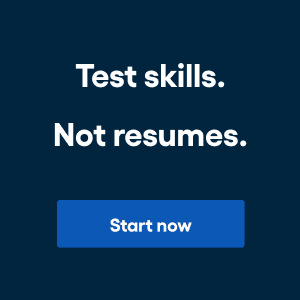Video interviewing is hardly a groundbreaking concept. It’s basically like normal interviewing, only without the recruiter. Recruiters write their questions down, and candidates record their answers on video.
The advantages of one-way interviewing are obvious. Candidates don’t have to take time off work to attend in-person interviews, and they can respond at a place and time of their choosing. Recruiters and employers can interview many more candidates and review their responses in their own time. In short, digital interviewing saves time for everyone.
The other advantage of using video interviewing is that it can be helpful to get a quick snapshot of how candidates communicate without necessarily having to commit to a full interview. More on this below.
That’s the upside, now let’s look at the downside.
Video interviewing can be a bad candidate experience
Not everyone likes video, it makes people self-conscious. I’m talking specifically about candidates. First, it can be confronting, terrifying even. Have you ever had to record yourself on camera? Now imagine doing it knowing you’re being assessed. Throw in a time limit and it’s a recipe for sheer terror.
Recording yourself again and again can be exhausting. It’s not a great candidate experience and there is enough evidence to suggest that it can adversely impact interview completion rates. On our own platform we discovered that when candidates are asked to answer three or more video question completion rates go down by 17%.
You can read more about creating a candidate-friendly candidate experience here.
Finally, video interviewing doesn’t really help candidates showcase their talent. It’s too one-dimensional. There are so many other ways candidates can prove their skills. For example, they can do actual tasks. Candidates for technical roles like software developers of designers wouldn’t consider video to be overly relevant because their work can be demonstrated without verbal communication.
Video interviewing on its own doesn’t really predict performance
Watching endless videos of candidates speaking won’t really tell you how capable they are. Just like traditional interviews won’t. Video interviewing is an online recreation of traditional job interviews. It’s more efficient, but not necessarily more effective. If you want to see how candidates perform, ask them to do real work. Put them in the scenarios they’ll face on the job.
When you’re reviewing candidate responses, you’ll find that after watching one or two videos you’ll already have a sense of what a candidate is like. There’s really no need to watch 12 more. It’s unnecessary. Instead, you want to see a healthy mix of answer types.
How to do video right
Video can be used very effectively as part of a scenario-based assessment, which we call a Talent Trial.
First, we’ve found that the right number of video-based answers you should seek is somewhere between one and two. That will help maximize candidate completion rates and also give you the right level of insight.
Second, one of the best ways to incorporate video into your online interviewing process is to add a video question immediately after a task. The idea is to ask candidates to explain their work. Candidates love talking about their wok and will likely do so with pride. And you’ll get to see how effectively they communicate about a topic they can discuss authoritatively.
Finally, focus on skill testing as the main way to evaluate candidates. Video, like any other answer type, is one form of media and should be used sparingly.




















